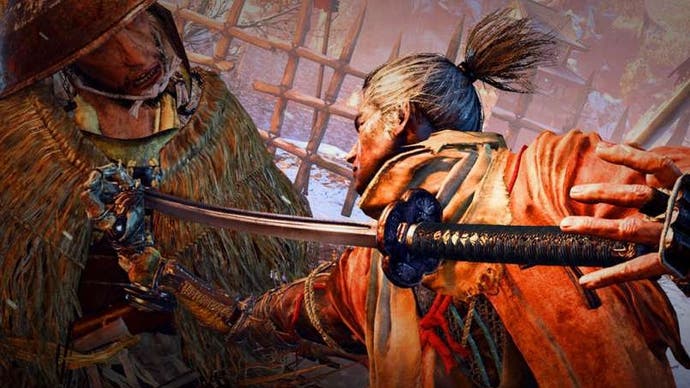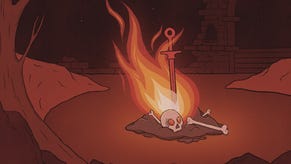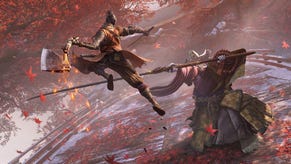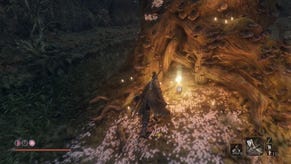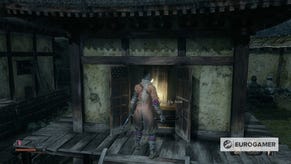Sekiro: Shadows Die Twice promises a thrilling evolution of the Souls formula
“The intention is the player will die a lot...”
Sekiro: Shadows Die Twice isn't exactly Dark Souls with a ninja reskin. For starters, Sekiro's protagonist is a set character, not a customisable avatar as per previous From Software titles. This titular playable character is a ninja sworn to protect a young lord - the ten-year-old boy seen in Sekiro's announcement trailer. There's something special about this boy and his bloodline that makes him a target to outside influences, and a clan called the Ashina send a samurai to capture him. In trying to protect his charge, the ninja hero has his arm cut off and is left for dead, and the young lord is taken. When the hero wakes up, he's got a strange contraption where his arm used to be that From is calling the Shinobi Prosthetic, and it's put there possibly care of the ambiguous character currently referred to as The Sculptor, who does most of the talking in the games's E3 trailer.
"With this ninja protagonist, he is the central character to the story, and that's how Sekiro differs from previous From Software titles, in that we have that core character to focus on," From Software president and Dark Souls director Hidetaka Miyazaki told me at E3. "That's not to say it'll be a story-driven game, but we do have these core characters like the Shinobi and his charge, the young lord seen in the trailer. We want to depict, at least initially, the relationship between the lord and retainer. That's a very Japanese concept, the shinobi and his master, and we're hopefully going to see how that relationship develops. We can't speak to a lot of it right now for fear of spoilers, but there is that dynamic there between these two characters, and this Shinobi who is extremely loyal to that cause. That's his primary motivation."
One of thing a lot of fans loved about the Souls series, however, was its almost archaeological approach to storytelling, the way the games didn't rely on cutscenes to dish out chunks of exposition but instead left clues hidden throughout the world for the most diligent players to piece together. Will a more character-driven story mean a more straightforward narrative? "It's a character-driven story this time, but it's not a story-driven game," Miyazaki said. "The player isn't going to be led down one linear path and have the story spoon-fed to them by many many cutscenes or anything like that. That aspect of From Software's previous games, of gradually picking the pieces up of a fragmented story and building those layers, building that depth, figuring things out for yourself, that's still very much intact in this game." The same goes for its physical layout - Miyazaki says Sekiro will be like Dark Souls 1 in the way that it interconnects, with multiple paths between each area - "with some exceptions." Players will also have choice in the order they complete the game in, From confirmed.
At the beginning of our live E3 demo, Sekiro is introduced as a third-person action adventure game "with RPG elements," set in late-1500s Japan, in the age known as the Sengoku or "Warring States" period. That said, as you would have gathered from the trailers featuring giant snakes and grotesque monsters, this is not a historical game - it's an original world created by From Software and Miyazaki that pulls on themes from that historical era. Miyazaki emphasised that the setting played a big part in shaping the game's creation. "This was actually a big impetus for the original early discussions for this game and what it was going to be," he explained. "We wanted to make a game based around ninja, in a Japanese setting. The reasons for that are twofold; one is that we can use things like the ninja's ability to jump - we can use it to freely traverse the map in a very three dimensional space and use that for our mobility and in combat and in exploration as well. The second is how you fight. We feel that samurai are a lot more grounded; they [hold their] weapon in two hands, they fight on the ground, there's just one way - that's their aesthetic. The Shinobi aesthetic is to use everything in their arsenal - use a multitude of tools, use their mobility. They can go toe-to-toe with their katana, but this guy can also use his Shinobi prosthetic. He can get the drop on enemies, he can ambush, he can use stealth. There's a multitude of ways that we can let the player express themselves in combat."
As the demo begins, we see the ninja protagonist perched on a high wall overlooking a courtyard, a large castle looming far in the distance. The goal of the demo, we're told, is to reach that castle, and our first objective will be to get down from this wall - an opportune moment to try out our character's Shinobi Prosthetic, specifically its grappling hook capability. Unsurprisingly, the inclusion of a grappling hook completely changes the traversal of Sekiro compared to previous From Software games - within seconds we're skimming over rooftops and rappelling over obstacles at surprising speed. It'll be interesting to see how the option of propelling rapidly through environments this way will change From's meticulous approach to map design; there are new layers of verticality where there simply wasn't before. That verticality, we discover as soon as we reach the ground and spot a procession of figures patrolling a path up ahead, also extends to combat. In perhaps the most radical departure of all from the Souls template, Sekiro features a dedicated jump button, and according to a producer, "it is crucial to success to use it well." As our protagonist approaches his enemies, we're told that another thing From wants to introduce in this game is what it's calling 'light' stealth mechanics. We're assured the focus with combat is, first and foremost, action - but stealth is an option that can allow you to thin the herd before engaging a mob or to turn the odds in your favour with encounters that are otherwise giving you trouble. For Miyazaki, the key concept of Sekiro is capturing that feeling of going sword to sword with an enemy, and how intense that can be.
Crucial to this and a central component to Sekiro's combat is the Posture system. In Sekiro, both the player character and enemies have something called Posture, which regenerates while not in battle. As the player, if you are hit by enemy attacks, your Posture is reduced, and if you don't block an incoming attack perfectly, you'll lose Posture as well. So if you hold the block button and an enemy keeps hitting you, you'll still block those attacks, but every time you do so, your Posture gauge will diminish. However, by pressing the block button right as an enemy hits you, you'll knock their sword back, there'll be a bunch of sparks, and you'll actually reduce your opponent's Posture instead. It's a struggle for the upper hand on both sides as each tries to force their opponent into running out of Posture, and when that happens to an enemy, you can initiate a Shinobi Death Blow - incredibly stylish and incredibly violent finishing moves. That's combat at its most basic level, but on top of that there's the Shinobi Prosthetic, which has multiple functions aside from acting as a grappling hook. When you're up against an enemy with a shield, for example, a tool called the Loaded Axe can break them. "There are some tools that let you directly attack enemies, ones that function as weapons like the Loaded Axe, and then there are other weapons of 'accentuated taste,' and utility-based tools like the Iron-Gripped Fan that is primarily used for defence," Miyazaki told us. There are also Shuriken, which can strike enemies from afar. You can follow that particular move up with a sword dash combo, which can allow you to close gaps very quickly. All this adds up to what looks like a satisfyingly complex system, exactly the kind you'd expect from Miyazaki and the Souls team. And yet, it is definitely different. It's akin to Bloodborne's more overtly offensive Trick Weapon and gun combo, with players using primarily a katana ("and there are several sword styles associated with that," Miyazaki says) and the Shinobi Prosthetic plus the wide variety of tools that come with it.
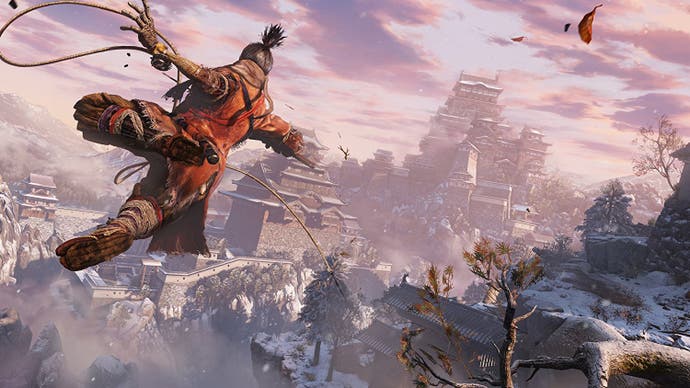
The enemies you'll use these skills against seem suitably varied and, most importantly, challenging. There are heavily armoured samurai generals, hard-hitting giants, snipers, and creepy old ladies who will alert other enemies in the area unless you take them out first. One particular mob of enemies caused the From Software developer playing to die and restart several times - Sekiro is punishing to those that make mistakes. "The intention is the player will die a lot," Miyazaki confirmed. "That is because of the concept of the ninja protagonist at its core; as a ninja you're a little less equipped than the average samurai or knight, you're always at death's door. We want every battle to feel intense - we want players to feel that risk and trepidation associated with battle and fighting toe to toe with these enemies. And in order to do that, the player has to die a lot. But when they die and respawn and die again, and then retry, that doesn't feel good. So, we needed something to address that, and that became the resurrection system."
After a couple of deaths that resulted in restarting the battle from scratch, the From developer fell to a manacled giant once more but, instead of going back to a checkpoint, he suddenly got back up from where he fell and recommenced the fight from where it had left off. As hinted at in the trailer, resurrection is an option in Sekiro but, From was keen to emphasise, it's not something you're going to be doing all the time. It's limited and there is a resource involved, and though the From developers didn't want to go into detail on the exact process just yet, they did say that the intent is for it to be a facet of potential strategy that you can use "to make death an opportunity to turn the tables." So, for example, you can wait for enemies to walk away, get back up, and use the element of surprise to try again. "We feel that as we integrated that and experimented with it, it became a part of the Shinobi protagonist's character," Miyazaki said. "It linked in nicely with that ninja 'anything goes' concept in that he can even use his own death as a strategic element in battle. One thing we want everyone to understand is we don't intend to make the game easier as a result or make the challenge any less effective. This was not created in order to make the player feel numb to death or make the player unafraid of death. We want them to still have 'the stench of death' present in every single encounter, if you will, so this is something that will be tuned and tweaked as we go forward. It's going to have its own restrictions and limitations, and we're going to have our own death penalty that fits this concept." From wouldn't go into more detail on what Sekiro's death penalty might look like, but it did say that "something different is planned." And, on the subject of healing, From would only say that though the build we saw is still in progress and pretty much everything is open to change, the way healing currently works in Sekiro is similar to Dark Souls' Estus in that "you have a set amount of charges that you can regain, and you can upgrade the amount of charges that you have."
By this point, we've crept steadily closer to the castle, but upon arriving at a cliff face we discover that the bridge is out - meaning we'll have to find another path forward using our Shinobi Prosthetic. Instead of heading up or over the chasm, however, we head down into its depths, where a gigantic snake (glimpsed briefly at the very end of the announcement trailer) is on the hunt. We need to get by it but don't want to be seen, so what follows is a very short sequence with the player sneaking from one path to another as the snake flits in and around corners overhead, attempting to hunt us down. In the final stretch, the snake saw us just as we reached a path leading out, lunging to take a bite and destroying part of the cliff face in the process. We clashed, sword to glistening fang, and it was beaten back for the time being. Apparently in the final game, that entire interaction will be 'significantly more involved.' A producer said, "One thing we're really excited for players to experience are these really tense cat and mouse sequences with these larger than life enemies."
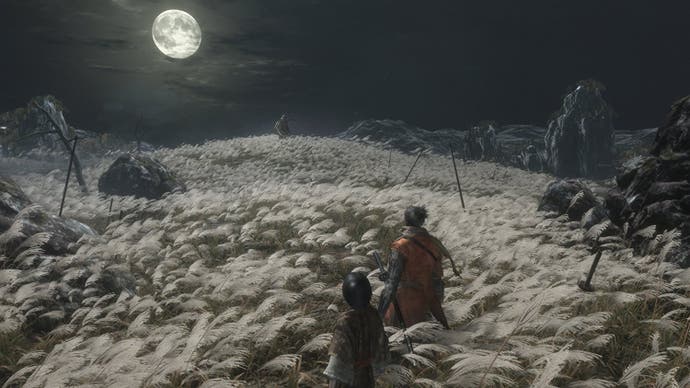
At the end of the tunnel we find ourselves in front of what From is "tentatively" calling a Shinobi Door. "It's opened in a special way, and it represents the fact that there will be secret paths that lead you to unexpected places and secret areas." Passing through this door we find ourselves standing in a beautiful traditional Japanese courtyard at sunset, where almost every surface is glowing red, orange and pink as cherry blossoms fall delicately from the trees. In addition to the gritty, bloody aspect of 1500s Japan, From is keen to represent the country's ancient, natural beauty. Before we can really drink it in, we step forward and initiate a boss fight. A swirling, towering, but undeniably elegant figure called the Corrupted Monk lunges forwards, laughing, grabbing, and clashing swords at a frightening rate - it's immediately clear that timing is crucial to gaining the upper hand here. Once enough damage has been exacted, however, the music becomes frenzied and the entire area becomes bathed in a blinding white light that more or less renders the entire fight in silhouette. It's an unexpected and extremely stylish touch that brings to an end an expectedly stylish demo. The Corrupted Monk was an unmistakably Miyazaki boss fight with a difference, but can we still expect that 'melancholic beauty' and reams of unspoken backstory that the director so loved to bring to the iconic boss battles of Dark Souls? "Of course!" he laughed, "But we hope this will be somewhat different from the Dark Souls approach, you won't just be going up against the big tough enemies - it does depend on the boss room and on the type of boss. There will be certain boss fights and certain larger than life enemies where you can use stealth as a tactical advantage."
It is of course difficult to look at any element of Sekiro without some degree of Dark Souls filter, but it's good to see that what was shown exhibits a healthy balance of both the familiar and new. "We didn't want to ignore our past experiences completely or ignore the previous games," Miyazaki said. "We wanted to take that know-how and apply that to this new franchise, this new package."
One of the things From is resolute about not borrowing from Dark Souls, however, is any kind of asynchronous multiplayer system - Sekiro will be a purely single-player experience. "We aren't considering a system similar to the messages or any asynchronous system," confirms Miyazaki when asked whether they were ever tempted to put something like that in the game. "That goes back to wanting to do something new; we don't want it to just be a repeat of what we've done before. And also it links nicely to the ninja protagonist - you can explore the map and you can find certain NPCs with certain intel and you can eavesdrop on them. You can find this info about the map, about the world, about the other enemies, about what's going on, about the lore, and you can use that to your advantage or you can use it to piece together various aspects of the story." To be clear, this lack of multiplayer also extends to summoning friends and non-NPC help, too. In previous titles you could summon other players to help you defeat a boss, and you don't have that in Sekiro - you are all by yourself. But, to counter this, there are other options that weren't there before, like stealth and special attacks that you've chosen to upgrade, and by doing so you may be able to figure out a way to defeat something that you weren't able to before. From confirms that Sekiro's progression system has moved away from using stats, saying that "something totally different will be in place," but "that feeling of getting stronger and the fact that you kill enemies to make you stronger is still going to be there." It's not really about finding and equipping armour any more, either - Sekiro will be more focused on how you upgrade, and how you'll find and gain new abilities that make you more powerful.

The move away from multiple classes is perhaps an unexpected one, but it makes sense in the context of From wanting to give players a strictly single-player focused experience. From spoke briefly about how it wanted to see "how far" it could take single player, and when you incorporate multiplayer and in particular multiple classes, it puts some limitations on the design. If you create a Dark Souls boss in a multiplayer, multi-class situation, it has to be designed in such a way that it can be taken down by a magic user, by a knight, or any combination of many different builds. So, From has made a decision in Sekiro to have just one class - ninja - and focus its enemy design to test that class specifically. In doing so, From says, it can increase the breadth of options that players have and experiment with how bosses can present new challenges. "It relates back to what we were saying about the ninja, and how they have a lot of things at their disposal and they have to master every part of their arsenal in order to confront these different situations," explained Miyazaki. "So we feel that this time, there are a lot of tools that we have prepared for the player, of various skill levels, so that if they want to run in there head-on, they can do that and clash sword-to-sword. If they want to use the Shinobi Prosthetic to outsmart their opponents and find that one weakness, they can do that. If they want to use stealth to circumnavigate an encounter and get the drop on the enemy and then engage, they can do that too, so there are a lot of ways they can approach battle - it's not just about being this high-reaction, twitch-based gamer."
Miyazaki also speaks positively about From's collaboration with Activision and adapting to the publisher's culture. He had broached this subject before with Japanese media, speaking briefly about adopting the publisher's 'onboarding process,' and calling it and the need for 'comfort' a weakness of From Software. We asked him for clarification, did he mean player comfort here? Does this mean Sekiro will take more time to explain its systems to players? "Yes, the tutorial is one aspect of that, which we are getting some much-needed support with," he said. "And it also depends on that level of comfort and playability that comes with the rest of the game. These things generally aren't our forte, but we do need some support, and Activision is providing that. One reason we're working with Activision is they hold our creative vision in the highest regard. From has editorial and directive control over the game and the game's contents; after you press the start button, it's all up to the From team. That said, we do need help with some things and we are getting advice from Activision, but they do 100 percent respect our vision and they do not want to mess with that core fanbase and that core gameplay concept."
Well, quite - messing with the Dark Souls fanbase would be an act akin to poking a hellkite dragon in the eye, but it will be interesting to see how this dedication to 'player comfort' will look as the game develops. It's hard to truly get the measure of something of this scope in such a short timeframe and without any kind of hands-on, but even in these early stages Sekiro does seem to exhibit all the style and substance we've come to expect of From.
